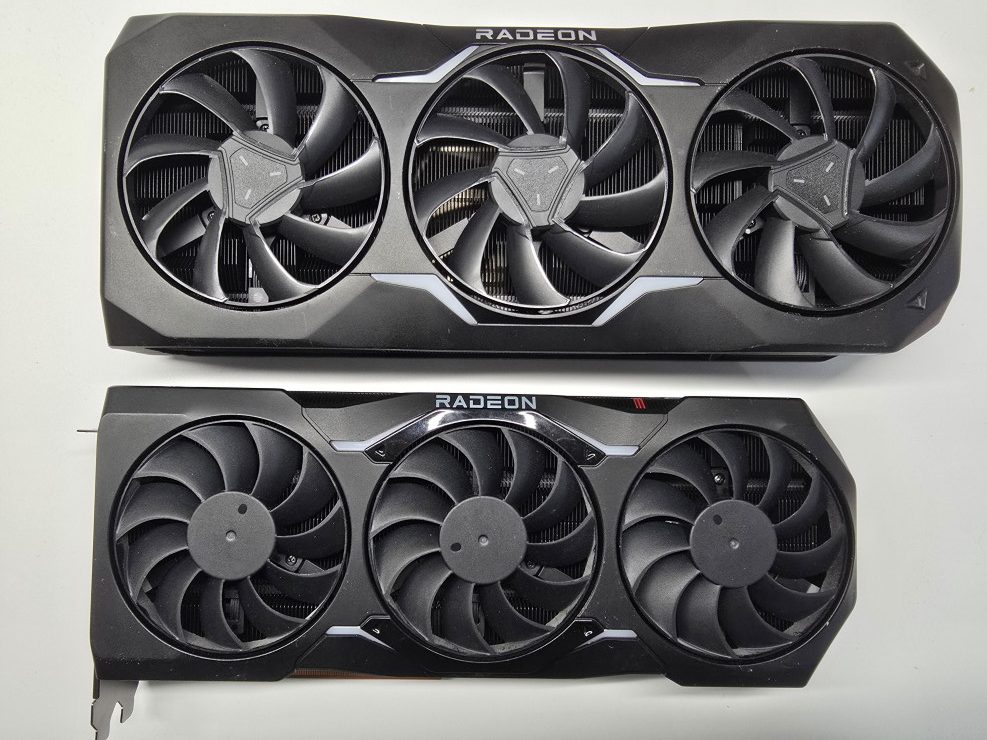In an intriguing revelation for the tech community, a prototype cooler associated with AMD’s Radeon RX 7000 series graphics cards has emerged online. This discovery has ignited speculation about AMD’s prior intentions to develop a high-performance GPU comparable to NVIDIA’s RTX 4090 during the RDNA 3 era. The leaks originated from the Korean forum Quasarzone, shared by a user identified as FP32, who showcased images of a uniquely designed cooler sourced from the Chinese marketplace Xianyu. While initially resembling the RX 7900 XTX’s design, a closer examination reveals significant alterations that hint at more ambitious specifications.
Specifications and Design Features
The most striking aspect of the prototype cooler is its size. Measuring nearly 34 cm in length, it noticeably surpasses the RX 7900 XTX, which measures 29 cm. The added thickness of 5.5 cm means it occupies three PCI slots instead of two, employing a triple-fan configuration for enhanced cooling. A key feature is its power design, allowing for three 8-pin connectors, indicating a total board power requirement likely exceeding 450W. Such specifications align it more closely with the power demands of NVIDIA’s RTX 4090, which is a significant consideration for enthusiasts looking for high-performance hardware. This cooler also sports red fins labeled “RDNA 3,” suggesting it is part of AMD’s next-generation architecture development.
A close-up view of the internal structure reveals a copper baseplate and an extensive heatpipe array designed to manage higher thermal outputs, further emphasizing its potential for accommodating demanding computing tasks. The internal configuration diverges sharply from the RX 7900 XTX, hinting that this cooler was intended for a more potent piece of hardware. However, the absence of a PCB within the cooler leaves its exact model and capabilities uncertain, as no direct testing can be conducted.
Rumors and Historical Context
The emergence of this prototype cooler raises questions about AMD’s design philosophy during the RDNA 3 development phase. While the RX 7900 XTX showcases impressive specs, featuring a fully unlocked Navi 31 die with 96 Compute Units, this cooler may have been part of efforts to explore higher clock speeds or augmented memory configurations. Speculations have circulated regarding potential models like the RX 7950 XTX and RX 7990 XTX since 2022, but this is the first concrete evidence illustrating AMD’s pursuit of a more potent “halo-tier” card that could compete directly with NVIDIA’s product line. Notably, sources such as Notebookcheck have discussed these rumored models, shedding light on AMD’s ambition to push boundaries.
Furthermore, even a year later, there were ongoing speculations regarding AMD’s unreleased cards, as highlighted in a Tom’s Hardware article. Despite hints of significant advancements, the company opted to pivot its strategy towards efficiency and price-to-performance ratios over raw power. This prototype cooler stands as a tangible reminder of what could have been had AMD decided to tackle the ultra-enthusiast market head-on.
Market Implications
The revelations surrounding this prototype could have substantial implications for AMD’s market positioning. By perhaps forgoing the development of a competitor to NVIDIA’s high-end offerings, AMD has focused on providing excellent performance at competitive prices, appealing to a broader audience that values both efficiency and cost-effectiveness. However, should AMD decide to return to a more aggressive high-end GPU strategy, this prototype indicates a foundational capability for crafting powerful GPUs that could elevate its position within the segment dominated by NVIDIA.
This development also echoes the patterns seen in the GPU industry, where tech companies often experiment with high-performing designs that never reach the consumer market. The cooling design implications indicate a trend where manufacturers are prepared to push the limits, even if the end product pivots towards a different target market. As the gaming landscape evolves, a potential shift back to high-performance GPUs could reshape competitive dynamics between AMD and NVIDIA.
As hardware enthusiasts dissect this prototype’s features and speculate on the potential paths AMD could take, it’s essential to keep an eye on the broader market trends and how they affect product releases in the near future. The discovery of this prototype cooler is not just a mere curiosity; it’s a key insight into AMD’s strategic decisions and aspirations within the GPU arena.

